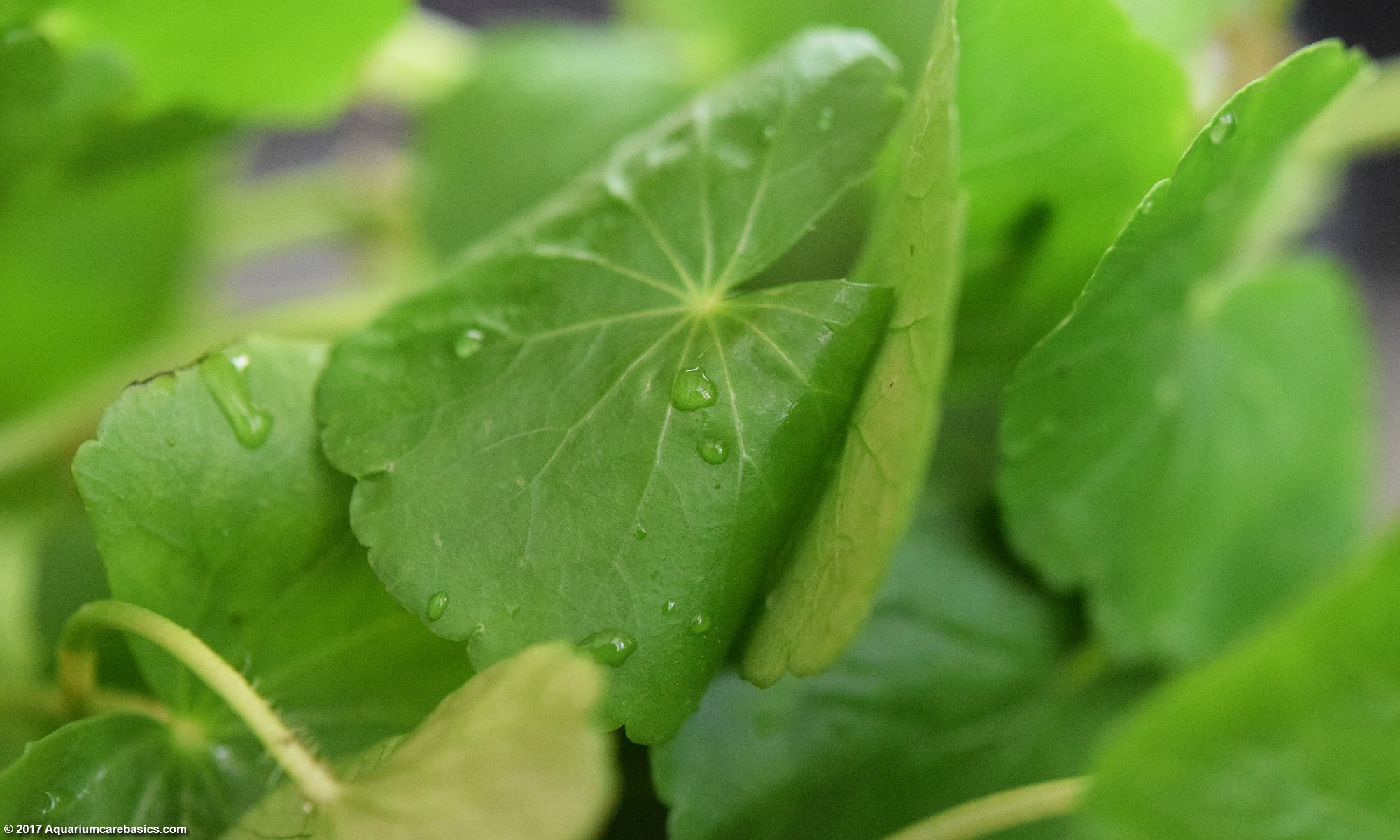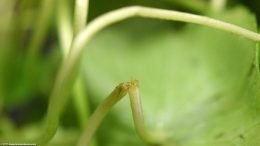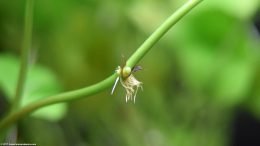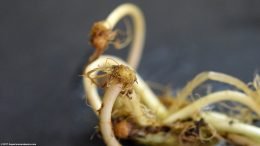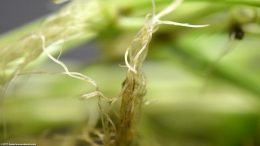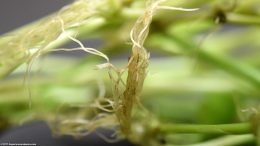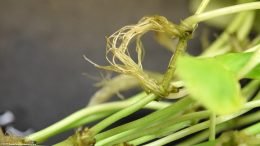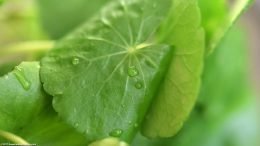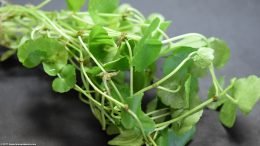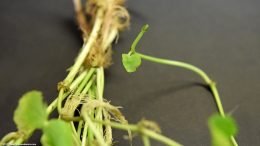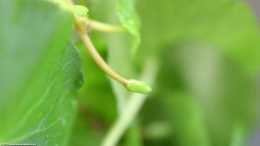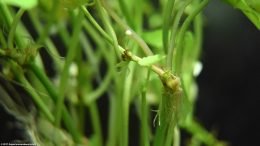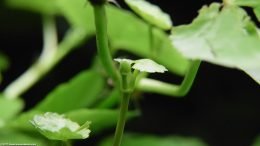A Brazilian Pennywort is a popular aquarium plant. Sometimes Brazilian Pennywort is sold in pet stores in plastic pots, or as trimmings bunched at the stem base with a rubber band. Brazilian Pennywort can also be sold under the names Brazilian Water Ivy, or simply as Pennywort. Brazilian Pennywort is versatile, easy to grow and easy to care for. That’s why Brazilian Pennywort is a great starter plant for beginners keeping freshwater community tanks.
When Buying Brazilian Pennywort Plants
When purchasing Pennywort, look for plants with healthy leaves and robust stems. Healthy Brazilian Pennywort leaves are light green and kidney shaped. Leaves should be free from cracks, tears, holes or discoloration. Brazilian Pennywort stems are vine-like, flexible and sturdy, so make sure they are also free from breaks, are not limp or turning brown. Brazilian Pennywort roots are white-ish in color and fine in texture as they appear under stem joints. Roots can resemble bean sprouts if they have been planted in substrate. Brazilian Pennywort may not be a good choice for tanks with rough fish like cichlids or goldfish. If there are any questions regarding compatibility, its best to check with the store clerk before buying.
Brazilian Pennywort Images
Here are some closeup shots of aquatic Pennywort plants. The fine details of new plant leaves, roots and stems are evident. What is particular noteworthy is just how delicate the new growth looks. Yet at the same time, as the plant ages it gets stronger fast and can hold its own against other fast growing aquarium plants.
Brazilian Pennywort Care Is Easy
One of the best parts about keeping this plant is that Brazilian Pennywort care is easy. It can be kept as either a rooted plant or floating plant. As a rooted plant, Brazilian Pennywort can be used in the midground or background. Some hobbyists even keep it in the foreground. When the plant is rooted, it will grow as a stem plant up toward the water surface and light source. As a floating plant, its leaves will grow up to the water surface creating shaded areas underneath. Floating Brazilian Pennywort can also provide cover for inhabitants looking for a safe place to rest or hide. Either way, Brazilian Pennywort growth rate can be fast if the conditions are right. Plant growth can take over a tank quickly, so plan the aquascape appropriately. Allow easy access points around decorations to trim away excessive growth.
Healthy Leaves
Brazilian Pennywort Leaves: As far as plant leaves go, Brazilian Pennywort leaves add a pretty green color to tanks. Upon close observation, Brazilian Pennywort leaves are different in look than some other aquarium plants like Water Sprite or Anacharis.
Brazilian Pennywort leaves look more like a plant leaf one would see in a back yard garden. Brazilian Pennywort leaves vary in size from about the size of a dime to about the size of a quarter. And in some cases, leaves can grow to be about the size of a half dollar. Leaves grow off the stem and have veins that radiate throughout the leaf. Veins originate at the area where the leaf is connected to the stem and extend outward from there. As the veins extend outward, the larger veins branch into smaller lateral veins providing support for the leaf. The leaf margins are rounded and can be slightly curled creating a subtle rippled effect. Brazilian Pennywort leaves are not slow growing, so algae buildup on the leaf blades is generally not a problem.
If leaves begin turning yellow, discoloration most likely with start near the leaf edge. Yellow Brazilian Pennywort leaves may be an indication that plant fertilizer with iron may be required.
Stems & Roots
Brazilian Pennywort Stems: Another interesting aspect of this plant is its stem structure. Brazilian Pennywort stems are grow in segments. Each segment has visible joints where leaves and roots connect. Brazilian Pennywort stems are hardy can support the plant in water.
For as durable as Brazilian Pennywort stems are, they can snap easily if tugged or bent. In most cases, stem damage occurs while trimming. Stem damage can also occur if hobbyists try to move the plant or move decorations. Another thing that can happen is the plant can grow into power filter intakes and stem damage can occur when trying to untangle that mess. The good news is, should the stem snap, there is a good chance that the damaged portion of the plant can live on its own.
Brazilian Pennywort Roots: These fine, delicate and string-like Brazilian Pennywort roots grow from the stem joint regardless of whether the plant is planted or floating. If the stem joint is close enough to the bottom, these string-like roots can make their way into the substrate and anchor that portion of the plant. Pennywort roots grow into systems sufficient to keep the plant in place, with the primary root and radicals being a bit thicker than roots of floating plants.
Water Conditions
Water Parameters: Brazilian Pennywort care is easy because the plant is so adaptable to a wide range of aquarium water conditions.
Aquarium pH: 6.0 – 7.8
Water Temperature: 68 – 82 degrees Fahrenheit
Tank Size: Any, but the plant can grow fast and take over quickly
Lighting: Wide range, community tank lighting should work fine
Some hobbyists suggest that Pennywort can help keep aquarium water quality up by helping keep Nitrate levels down. Some hobbyists also suggest that Pennywort is one of the best live aquarium plants for this purpose. That said, its important to keep in mind that the best way to control Nitrate levels is to keep organic matter from building up in the aquarium by not overfeeding, not overstocking, and conducting regular partial water changes. Pennywort is not a Nitrate miracle worker if tank maintenance is not right.
Growth &Trimming
Growth Rate: Pennywort can be a fast growing plant in both low light, low tech tanks, as well as in more sophisticated setups. And all things being equal, the more intense the lighting is, or the more hours light is available, the faster the plant should grow. Supplementing with plant fertilizers can cause Pennywort to grow like crazy as well. That said, some hobbyists have stated that some liquid plant fertilizers may melt the plant away. So before adding fertilizers, research the effects of the particular fertilizer on Pennywort. And with all fertilizers, make sure they are not harmful to the inhabitants of the tank. Aquarium shrimp and some types of snails may be sensitive to some of the fertilizer’s ingredients, especially copper.
Trimming: Trimming Brazilian Pennywort may be necessary when the plant stems begin to outgrow their space in the tank. Under the right conditions, stems can sometimes grow longer than two feet. Select the portion of the stem needed to be trimmed and gently snip it with trimming shears. When trimming excess growth be careful not to pull or tug at the stem and make avoid tearing the plant.
Reproduction & Propagation
Reproduction: Brazilian Pennywort reproduction is generally easy. Simply trim a couple inches of stem, with plenty of leaves, off the parent plant and let it float in the water. If the trimmed stem is long enough, plant the trimmed end into the substrate. In about a week or so, the trimming should begin to grow roots. Soon thereafter, the plant will be growing on its own. Pennywort can even be reproduced from a single healthy leaf provided there is a piece of stem attached to it. Just let the leaf float independently in the water. In most cases, the leaf and stem will grow roots on its own.

